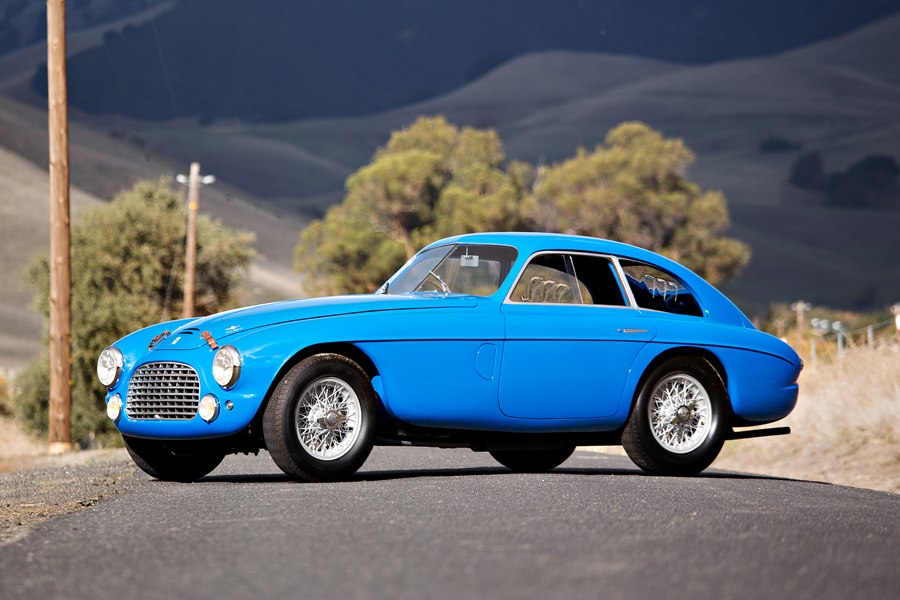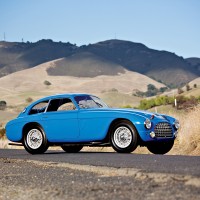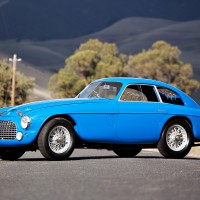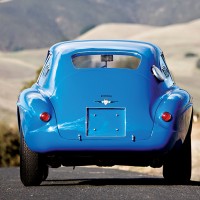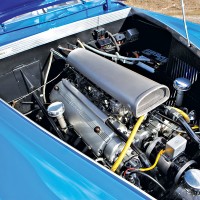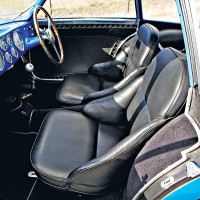SCM Analysis
Detailing
| Vehicle: | 1950 Ferrari 166 MM/195 S Berlinetta Le Mans |
| Years Produced: | 1950 |
| Number Produced: | One |
| Original List Price: | About $9,000 |
| SCM Valuation: | Only one exists, so there is no current median sale. The high sale of this car is the most-recent $6,490,000 |
| Tune Up Cost: | $3,000 |
| Distributor Caps: | $200 (for reproductions) |
| Chassis Number Location: | Side frame rail toward the front of the engine |
| Engine Number Location: | Stamped on a flange on the rear passenger’s side of block |
| Club Info: | Ferrari Club of America |
| Website: | http://www.ferrariclubofamerica.org |
| Alternatives: | 1947–53 Maserati A6GCS, 1949 Cisitalia 202MM Nuvolari Spyder, 1953–55 Fiat 8V Zagato |
| Investment Grade: | A |
This car, Lot 33, sold for $6,490,000, including buyer’s premium, at the Gooding & Company auction in Scottsdale, AZ, on January 29, 2016.
Enzo Ferrari mastered the skills of directing an International automobile race team while working at Alfa Romeo. He was sent into the field to recruit drivers, engineers and suppliers for Alfa and excelled at his task.
Dwindling resources forced Alfa to cut back their racing activities, which led Ferrari to form the famous Scuderia Ferrari as a side venture.
Scuderia loosely translates to “squad” or “team.” The Scuderia was structured to provide cars and support for wealthy patrons who wanted to go racing. As winning became more important than fun, veteran drivers often replaced the owners in the Scuderia’s cars.
A shake-up at Alfa resulted in Enzo Ferrari being shown the door and led to the founding of Auto-Avio Costruzioni. Auto-Avio fabricated parts for the automotive trade. The firm would also construct two cars for the 1940 Mille Miglia. They would be the first automobiles produced by Ferrari; however, a non-competition agreement between Ferrari and Alfa would prevent the cars from wearing the Ferrari name. Named Auto-Avio Costruzioni 815, the cars would have an impressive racing career.
World War II interrupted racing, and Auto-Avio shifted production to products for Mussolini’s war effort. The work would help Ferrari collect the equipment and personnel to start his own car company.
Ferrari is born
After the war, in 1947, Ferrari S.p.A. was founded.
The mission of Ferrari S.p.A. was to produce race cars. Scuderia Ferrari, the factory race team, would promote the business. The first car produced was the 1947 125 S. The 1.5-liter 125 S was the first 12-cylinder Ferrari and the first Ferrari to bear the Ferrari name.
The Type 125 was quickly replaced with the larger-displacement Type 159 model.
Then Ferrari struck gold with the new 2-liter Type 166. Great performance and a selection of attractive models made the 166 the hot ticket of the late 1940s and early 1950s. One particular model, a Touring-bodied Berlinetta, probably was the inspiration for the dual-purpose berlinettas that followed.
Touring body is a reference to a body builder — not an intended use. Touring — or more correctly, Carrozzeria Touring Superleggera — developed a process of building a lightweight body by wrapping a tubular substructure with lightweight panels. The process is called Superleggera, or super lightweight.
Aston Martin, Lamborghini, Pegaso and Lancia are just a few of the manufacturers besides Ferrari to commission Superleggera models.
Touring built as many as six 166 Berlinettas. The model was nicknamed 166 Touring Berlinetta Le Mans in honor of a 166 Barchetta MM winning Le Mans in 1949. The Berlinetta Le Mans featured handsome Superleggera coachwork and Ferrari’s 2-liter, Colombo-designed V12.
Finding that the 166 engine didn’t have quite enough oomph, Ferrari upgraded several 166s to 195s by boring their engines out to 2.3 liters. All but one of the 2.3-liter Berlinetta Le Mans cars were converted back to 2-liter 166 specs. Chassis 0060M kept its 2.3-liter engine, which is still installed today. As Ferraris traditionally are named after their engine, 0060M was renamed 195 S for the 195-cc displacement of a single cylinder.
Race history and famous owners
Chassis 0060M had a light — but impressive — race history. Several significant drivers piloted the car, and a Who’s Who of Ferrari enthusiasts have owned the car.
Chassis 0060M was a Paris show car, Best of Show at a Ferrari Club of America National Concours, second in class at Pebble Beach, and shown at the Cavallino Classic.
In modern times, chassis 0060M has participated in the Mille Miglia revival no less than seven times. It has been to the Coys Historic Festival twice and participated in the Goodwood Festival of Speed.
The car has been on the cover of Motorsport magazine and The Prancing Horse (twice). It has been the subject of a feature article in The Prancing Horse and received a mention in Road & Track.
A charmed life for a racer
Despite extensive use, the car has survived relatively unscathed. A non-racing shunt damaged the left front, but otherwise 0060M has escaped major damage.
Evidence of welding on the block reveals some type of previous catastrophic engine failure. The repair dates back 40 years with no reoccurrence, so that’s a non-issue.
An extensive restoration in 1999 brought the car up to Pebble Beach standards. It has been used little since and is described as still being in show condition.
The right people in the tent
A car can get lost in Scottsdale auction week, but fortunately, Gooding did their job in getting 0060M in front of the right people and keeping their attention.
The “Little Blue Coupe,” as it is sometimes called, sold at the very top of a rather optimistic estimate. The result was impressive but not unexpected for such a dazzling car.
It is a one-of-a-kind example of a beloved Ferrari 166. It has history up the … well, let’s just say, it has a lot of history. It is a car that is welcome at every important event on the planet.
Neither side had an advantage in this sale. The seller got all the money, but the buyer got great value. There’s no money left — the car sold at full price — so you’re more likely to see 0060M at a vintage event rather than a future auction. ♦
(Introductory description courtesy of Gooding & Company.)
